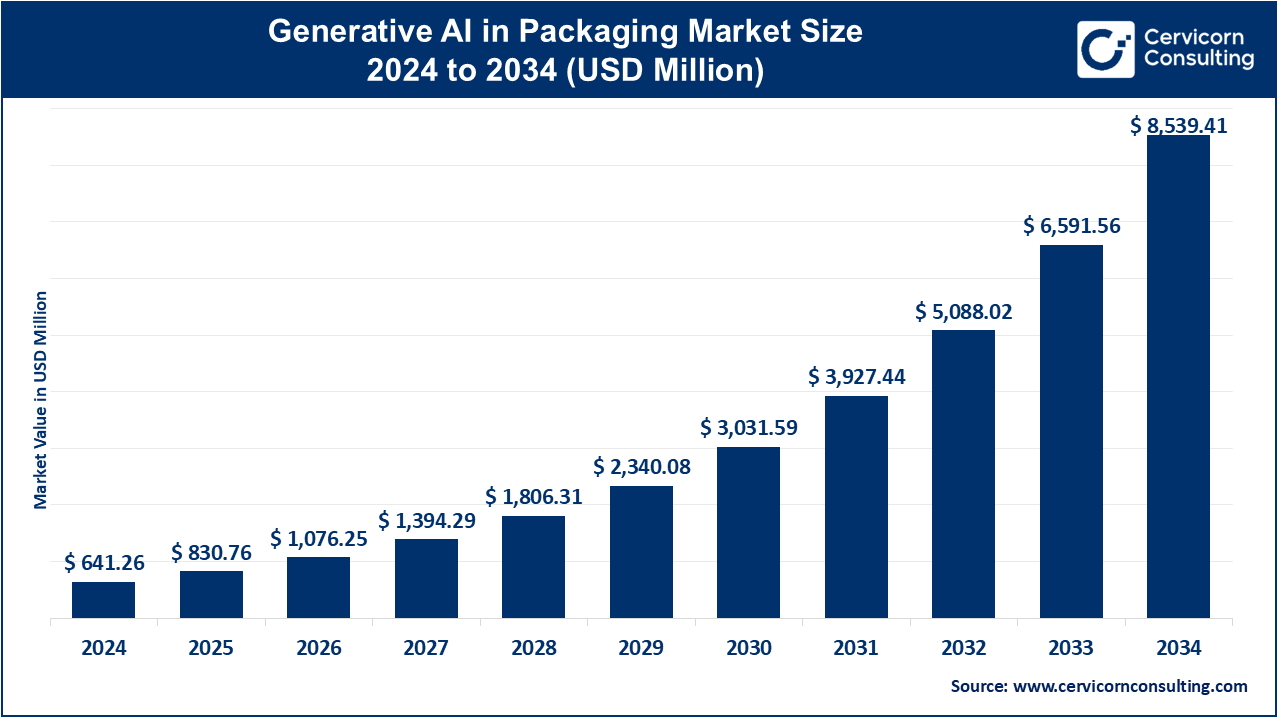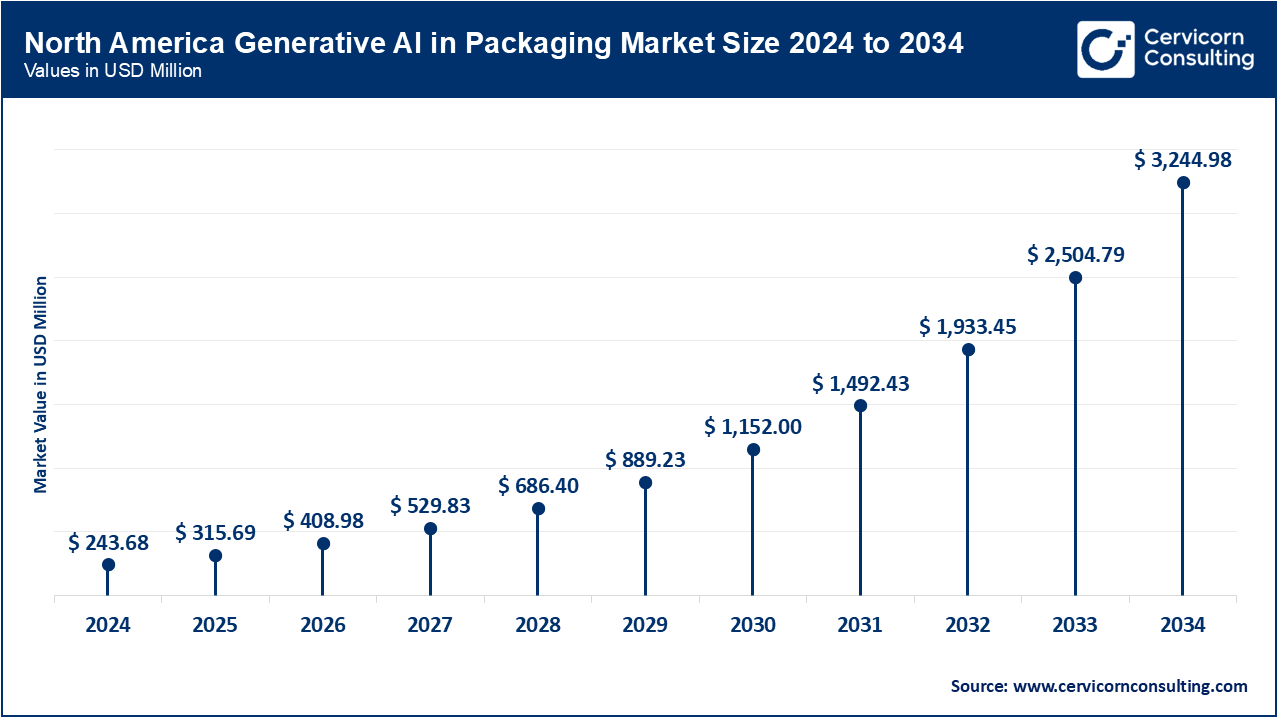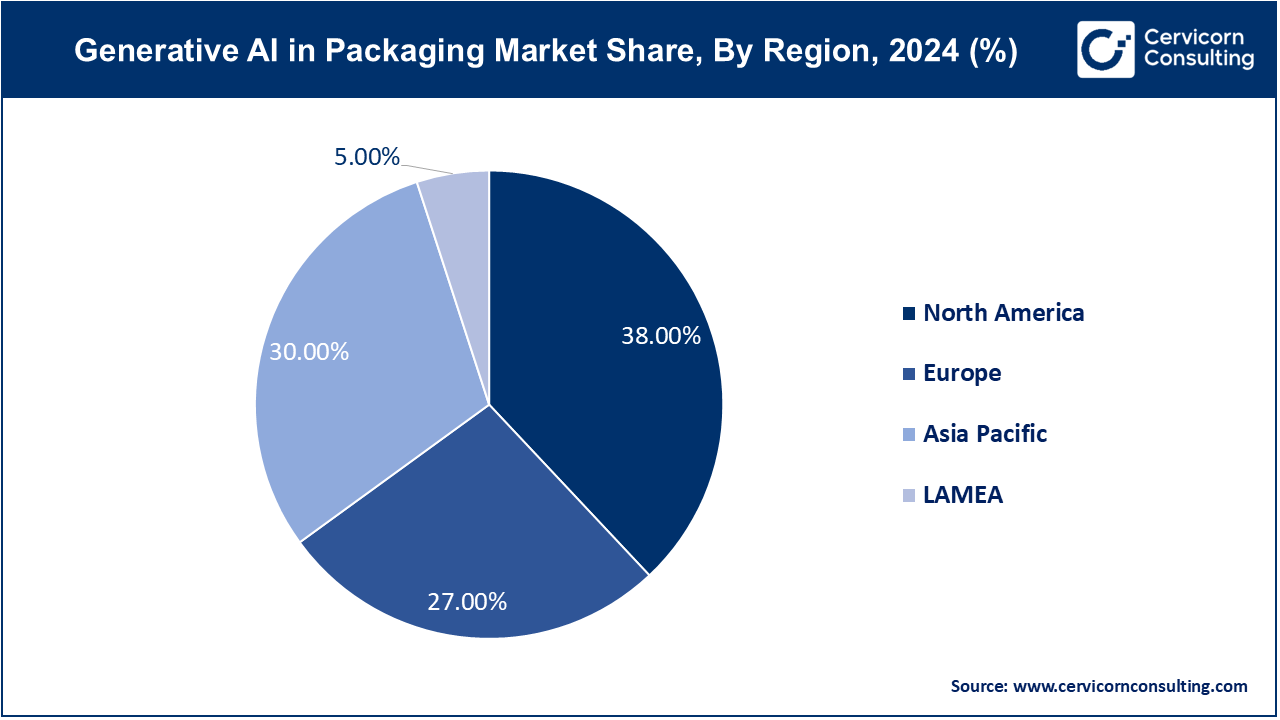The global generative AI in packaging market size was valued USD 641.26 million in 2024 and is expected to be worth around USD 8,539.41 million by 2034, exhibiting a compound annual growth rate (CAGR) of 29.55% over the forecast period 2025 to 2034. The generative AI in packaging market growth is primarily driven by the increasing demand for automation and efficiency in design processes. Conventional packaging designs tend to be labor-intensive and time-consuming; however, generative AI tools can swiftly adapt to brand specifications, stability targets, and particular criteria like consumer preferences. This greatly shortens time-to-market and lowers development costs. Moreover, the increasing need for personalized packaging is motivating consumer-driven products to embrace AI, facilitating scalable and on-demand packaging design.

Another key factor contributing to this development is the incorporation of generative AI with stability initiatives. Brands face pressure to minimize waste and carbon emissions, and generative AI aids in optimizing material usage by simulating and evaluating different structural designs before production. Additionally, improvements in machine learning and AI platforms are enhancing the accessibility of these methods for packaging companies of all sizes, including small and medium enterprises (SMEs). As digital transformation accelerates across various industries, the packaging sector is quickly adopting AI to maintain competitiveness, enhance supply chain efficiency, and offer data-driven packaging solutions.
What is a Generative AI in Packaging?
Generative AI in packaging involves using sophisticated algorithms to create and modify packaging designs according to parameters like material efficiency, stability objectives, and consumer preferences. These AI systems can quickly produce innovative packaging ideas, simulate their performance, and improve the design autonomously. Key applications include automated structural design, personalized packaging for targeted marketing, optimized material use for stability, and virtual testing for durability and compliance. By adopting generative AIs, companies can speed up product development cycles, lower costs, and enhance customer engagement with tailored packaging solutions.
Applications of Generative AI in Packaging
| Insight | Details |
| Adoption in Packaging Design | Generative AI tools are increasingly used for creating innovative and efficient packaging designs, enabling rapid prototyping and customization. |
| Sustainability Initiatives | AI-driven design optimization contributes to material reduction and waste minimization, supporting environmental sustainability goals. |
| Integration in Supply Chain Management | Generative AI aids in optimizing packaging for logistics, enhancing space utilization and reducing transportation costs. |
| Enhanced Consumer Engagement | Personalized packaging experiences are facilitated by AI, allowing brands to connect more effectively with individual consumers. |
| Innovation in R&D Processes | AI accelerates research and development by simulating various packaging scenarios, leading to faster innovation cycles. |
AI-Driven Sustainability and Material Optimization
Generative AI algorithms analyze design parameters alongside environmental data to propose packaging that uses fewer raw materials without compromising strength or protection. This includes the adaptation of shapes, thickness, and material types-sometimes suggesting a bio-based or recycled option. AI can simulate the environmental impact throughout the life cycle of a product, which can help brands meet regulatory requirements and consumer expectations for environmentally friendly packaging. It reduces both costs and carbon footprints, supporting the initiative of the circular economy.
Hyper-Personalization in Packaging Design
Generative AI allows brands to customize packaging in response to consumer demographics, purchasing habits, and current trends. For instance, customers of cosmetics brands can receive personalized labels featuring unique designs or messages generated in real-time by AI based on relevant data. This level of personalization transcends just visuals; AI can also propose different colors and finishes tailored to attract specific audiences. The outcome is a deeper emotional bond, improved brand recognition, and boosted sales, particularly in the direct-to-consumer (DTC) market.
Integration of AI in Predictive Maintenance and Quality Control
Integrating generative AI models with internet of things (IoT) sensors in packaging production lines allows manufacturers to track machinery health and packaging quality in real time. The AI predicts possible defects before they lead to disruptions, facilitating preventive maintenance. Additionally, it aids in spotting quality deviations—like incorrect enhancements or structural flaws—enabling swift corrective measures. This modern strategy enhances uptime, lowers scrap rates, and ensures adherence to industry standards.
Enhanced Supply Chain and Logistics Optimization
Generative AI assesses product dimensions, fragility, and shipping constraints to recommend the best packaging size and materials. It reduces empty space in the shipping box, lessens the need for fillers, and decreases both shipment volume and weight. Advantages include reduced shipping costs, improved warehouse space utilization, and lower emissions from transport. Additionally, the AI facilitates real-time adjustments in response to shifting demand or shipping routes, enhancing supply chain flexibility.
Report Scope
| Area of Focus | Details |
| Market Size in 2025 | USD 830.76 Million |
| Expected Market Size in 2034 | USD 8,539.41 Million |
| Projected CAGR from 2025 to 2034 | 29.55% |
| Dominant Region | North America |
| Fastest Growing Region | Asia-Pacific |
| Key Segments | Technology, Application, Deployment Mode, End User, Region |
| Key Companies | Adobe Inc., OpenAI, Midjourney Inc., Canva, Amazon Inc., Microsoft Corporation, GE Digital, ABB Group, Cognex Corporation, Clarifai, Neurala, PackageX Inc. |
Rising Demand for Customization and Personalization
Push Toward Sustainability and Eco-Friendly Packaging
High Implementation Costs for SMEs
Limited Technical Expertise in the Packaging Sector
AI Integration with Augmented Reality (AR) and Virtual Testing
Expansion in E-commerce and D2C Channels
Data Privacy and Security Concerns
Resistance to Change in Traditional Manufacturing Setups
The generative AI in packaging market is segmented into various regions, including North America, Europe, Asia-Pacific, and LAMEA.
The North America generative AI in packaging market size was valued at USD 243.68 million in 2024 and is expected to hit around USD 3,244.98 million by 2034. North America leads the market due to its strong technological infrastructure, early AI adoption, and a well-established packaging industry. The presence of major tech giants and packaging companies, especially in the US, drives innovation in automated packaging design, predictive quality control, and personalisation. Strong consumer demand for customised products also fuels further adoption. Furthermore, sufficient investment in AI R&D, combined with collaboration between software developers and packaging firms, makes North America a key player in this market.

The Asia-Pacific generative AI in packaging market size was accounted for USD 192.38 million in 2024 and is projected to surpass around USD 2,561.82 million by 2034. APAC is witnessing the fastest growth, driven by swift industrialisation, flourishing e-commerce, and substantial progress in manufacturing automation. Countries like China, Japan, South Korea, and India are implementing generic AIs in packaging to quickly adapt to costs, improve material efficiency, and facilitate mass adaptation. A rising middle class, surging demand for consumer goods, and robust government support are further bolstering market expansion for AI technologies. Local packaging companies are also adopting AI to boost their competitiveness in global supply chains.
The Europe generative AI in packaging market size was reached at USD 173.14 million in 2024 and is predicted to reach around USD 2305.64 million by 2034. Europe is a strong market for generative AI in packaging, driven by strict environmental regulations and a strong focus on sustainability. European companies are using AI to create eco-friendly, recyclable, and minimalist packaging. The European Union's Green Deal and Circular Economy goals have led many packaging firms to use AI for material efficiency, life-cycle analysis, and reducing environmental impact. Furthermore, Germany, France, and the UK have advanced manufacturing capabilities that support high adoption rates of simulation, testing, and design automation technologies.

The LAMEA generative AI in packaging market size was valued USD 32.06 million in 2024 and is anticipated to reach around USD 426.97 million by 2034. The LAMEA region (Latin America, the Middle East, and Africa) is in the early stages of adopting generative AI for packaging, but interest is growing. Although infrastructure and investment are still evolving, rising demand from the food, beverage, and pharmaceutical sectors is creating new opportunities. Countries like Brazil, the UAE, and South Africa are starting to use AI for automation and cost efficiency in packaging. As AI tools become more widely known and accessible, the region is likely to see a gradual increase in adoption, particularly through partnerships and technical collaborations.
The generative AI in packaging market is segmented into application, technology, deployment model, end-use industry, and regions. Based on application, the market is classified into automated packaging design, material optimization, personalization and segmentation of one, predictive maintenance and quality control, and supply chain and logistics optimizations. Based on the technology, the market is categorised into generative design AI, computer vision, natural language processing (NLP), and AI-powered simulation and testing. Based on deployment mode, the market is categorised into on-premises and cloud-based. Based on End-Use Industry, the market is classified into consumer-packaged goods (CPG), E-commerce, food and beverage, pharmaceuticals, cosmetics and personal care, and others.
Automated packaging design is the most widely adopted application, as it significantly streamlines the creative and production processes. Utilizing generative AI, packaging designers can instantly generate numerous design variations based on material types, weight, dimensions, and brand guidelines. This automated design cycle not only saves time and reduces errors but also lowers prototype costs. It's especially favored in industries with rapid product turnover, like FMCG, where swift innovation and speed are necessary for the market.
Personalization and segmentation are gaining rapid momentum as consumer expectations shift toward hyper-customization. Generative AI empowers brands to develop personalized packaging experiences tailored to user demographics, behaviors, or even real-time interactions. This shift is transforming marketing strategies, enabling brands to effectively engage customers through targeted messages and designs. This approach is particularly impactful in sectors such as e-commerce and cosmetics, where packaging is crucial to the customer journey.
Generative Design AI is the cornerstone of AI-driven packaging innovation. This design utilizes advanced algorithms to identify and assess patterns beyond human capability. Companies use it to accomplish objectives like minimizing material usage, enhancing efficiency, improving visual aesthetics, and reducing waste. This method not only assists in achieving sustainability targets but also streamlines supply chain dynamics, making it the most widely used technology in packaging sectors.
AI-powered simulation and testing is experiencing accelerated growth as it allows companies to evaluate packaging under diverse conditions like pressure, temperature, and transport stress. This innovation decreases reliance on physical prototypes and accelerates decision-making processes. Furthermore, it guarantees compliance with safety regulations and bolsters quality control, particularly in critical sectors like pharmaceuticals and food packaging, where precision and resilience are essential.
Cloud-based deployment continues to dominate the market due to its flexibility, cost-effectiveness, and accessibility. This model enables users to access the AI tool from any location, collaborate from diverse sites, and smoothly integrate with existing design and production software. Additionally, cloud platforms offer immediate updates and storage solutions, minimizing overhead costs. This approach is particularly beneficial for enterprises seeking AI capabilities without the need for substantial upfront investment in infrastructure.
Conversely, on-premises deployment is gaining traction, particularly in highly regulated industries where data privacy, security, and operational control are critical. Companies handling sensitive consumer information or proprietary designs often opt for local infrastructure to mitigate third-party risks. While this approach requires more capital investment, on-premises systems provide enhanced performance, better integration with legacy equipment, and adherence to internal governance standards.
Generative AI in Packaging Market Revenue Share, By Deployment Mode, 2024 (%)
| Deployment Mode | Revenue Share, 2024 (%) |
| Cloud-Based | 57% |
| On-Premises | 43% |
The consumer-packaged goods sector leads the generative AI in packaging market, driven by a high volume of SKUs, fierce competition, and regular product introductions. Brands utilize AI to create innovative packaging that enhances shelf visibility, maintains product quality, and meets sustainability targets. Furthermore, AI aids in forecasting consumer trends, informing packaging changes that resonate with the intended audience. Consequently, CPG companies are among the foremost users of generative AI technology.
E-commerce represents the fastest-growing end-user segment as online retailers strive to enhance packaging for shipping, storage, and brand experience. Generative AI facilitates the creation of packaging that is both sturdy and visually appealing, meeting requirements like damage prevention and improved unboxing. As Direct-to-Consumer (D2C) brands expand, AI helps businesses customize packaging according to customer preferences, seasonal demands, and marketing tactics—all essential in today’s digital-first landscape.
The competitive landscape of generative AI in packaging industry is expanding rapidly, marked by a mix of established packaging companies, AI technology providers, and innovative startups. Key players are focusing on strategic collaborations, acquisitions, and integrations of AI-powered design and automation tools to gain a technical advantage. Companies are investing heavily in R&D to develop solutions that meet major market demands, including stability, adaptability, and operational efficiency. The competition is intensifying as companies vie to offer end-to-end AI capabilities – from product design and simulation to maintenance forecasting and individual packaging – across various industries, including consumer packaged goods, e-commerce, and pharmaceuticals.
Market Segmentation
By Technology
By Application
By Deployment Mode
By End-Use Industry
By Region